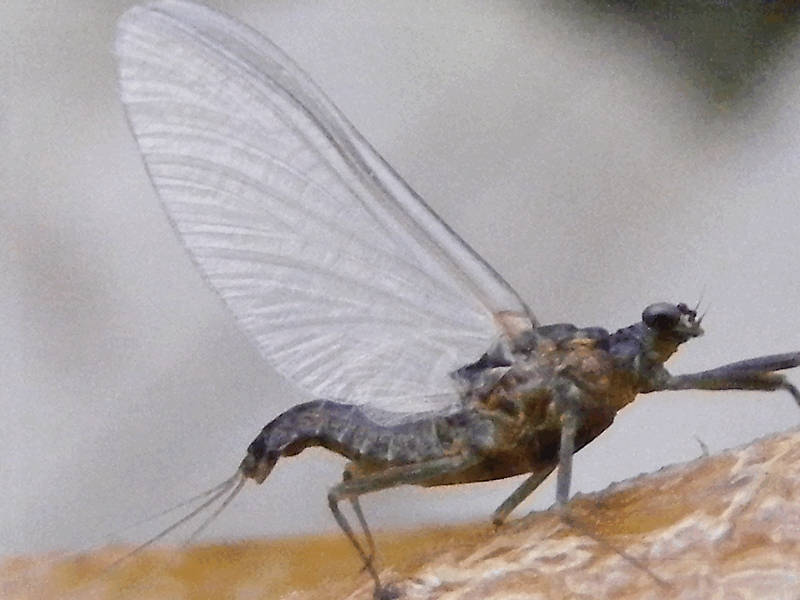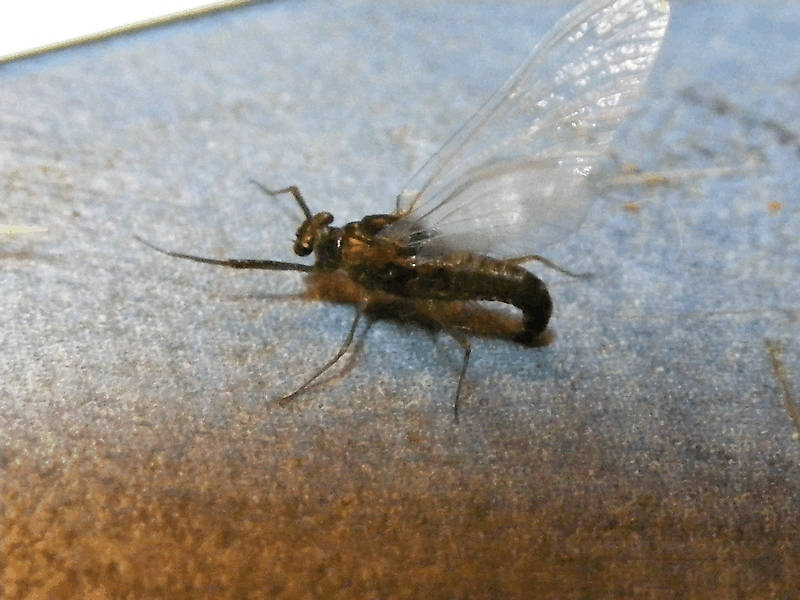Blog & Latest Updates
Fly Fishing Articles
Insects by Common Name


> > need an Id
| Sandfly | January 15th, 2015, 10:40 am | |
| tioga co. pa. Posts: 33 | hatches in june, | |
| sandfly shop owner N.J.B.B.A. #2215 Tiadaughton T.U. 688 I didn't Escape------They gave me a day pass ! | ||
| Martinlf | January 15th, 2015, 10:49 am | |
Moderator Palmyra PAPosts: 3233 | Size? | |
| "He spread them a yard and a half. 'And every one that got away is this big.'" --Fred Chappell | ||
| Sandfly | January 15th, 2015, 11:15 am | |
| tioga co. pa. Posts: 33 | size 16 hook | |
| sandfly shop owner N.J.B.B.A. #2215 Tiadaughton T.U. 688 I didn't Escape------They gave me a day pass ! | ||
| Entoman | January 15th, 2015, 3:20 pm | |
| Northern CA & ID Posts: 2604 | The stout body and dramatic abdominal taper point to the genus Drunella. Telling the female adults apart taxonomically is way beyond my feeble skills but this specimen's size is on the small side for cornuta. My guess would be either cornutella or lata. From an angling perspective it's probably a distinction without a difference. Both are commonly called Small Blue-winged Olives. | |
| "It's not that I find fishing so important, it's just that I find all other endeavors of Man equally unimportant... And not nearly as much fun!" Robert Traver, Anatomy of a Fisherman | ||
| Crepuscular | January 15th, 2015, 4:06 pm | |
| Boiling Springs, PA Posts: 923 | Pine Creek? Right after the drakes? Drunella tuberculata see here: http://www.troutnut.com/topic/6711/2/Pine-Creek-Ephemerellid#31584 | |
| Timman | January 15th, 2015, 4:33 pm | |
Banned white deer pike PAPosts: 10 | I vote for lata. The abdomen in thinner than tuberculata like the sample posted. | |
| Fake account made by Brookyman (who was banned for threatening another user) | ||
| Crepuscular | January 15th, 2015, 5:53 pm | |
| Boiling Springs, PA Posts: 923 | I vote for lata. The abdomen in thinner than tuberculata like the sample posted. What if she already laid her eggs? | |
| Timman | January 15th, 2015, 6:09 pm | |
Banned white deer pike PAPosts: 10 | To the best of my knowledge the only time the abdomen shrinks is when the adults reach the dehydration stage within hours of termination. I could be a Drunella tuberculata I just think lata is more likely. | |
| Fake account made by Brookyman (who was banned for threatening another user) | ||
| Crepuscular | January 15th, 2015, 7:53 pm | |
| Boiling Springs, PA Posts: 923 | To the best of my knowledge the only time the abdomen shrinks is when the adults reach the dehydration stage within hours of termination. I could be a Drunella tuberculata I just think lata is more likely. Oh yeah it could be D.lata but I think the abdomen has to contract a little after oviposition.And the way the female in the photo is holding her abdomen like there used to be a ball of eggs there tells me she has already deposited her eggs. Based on my experience with Pine Creek in June, D. tuburculata is a very significant emergence. I hope sandfly responds with where it was collected. So I suppose like Kurt pointed out once again faced with a female of a genus that is not easy under good circumstances to separate out the species. At least we are close on genus. ;) | |
| PaulRoberts | January 15th, 2015, 10:12 pm | |
| Colorado Posts: 1776 | Pure awesomeness. | |
| Timman | January 15th, 2015, 10:16 pm | |
Banned white deer pike PAPosts: 10 | Contraction and shrinkage are two different actions. The 8th - 10th look ever thin on the sample and thicker on the tuberculata specimen. That viewpoint is based on and is more visible in photo #2 She may have egged out, it is tough to say but it looks like both tuberculata & lata are very plausible. | |
| Fake account made by Brookyman (who was banned for threatening another user) | ||
| Entoman | January 15th, 2015, 10:29 pm | |
| Northern CA & ID Posts: 2604 | Ah, I think you're probably right, Eric. Local info is always the best. I shouldn't have limited it to those two by implication. Walkeri was another viable option I neglected to mention as well. I see nothing in the photos that helps taxonomically to rule any of them out. Heck, I can't even eliminate cornuta with absolute certainty - though I think I'm probably safe based on size and time of year with that one. The curved abdominal posture is common with all ephemerellid females. A foreshortening and loss of mass occurs during ovipositing and that has certainly occurred here. However, I'm not sure of the relevance as any differences in general abdominal conformation between these species have not been documented as having any diagnostic value to my knowledge. | |
| "It's not that I find fishing so important, it's just that I find all other endeavors of Man equally unimportant... And not nearly as much fun!" Robert Traver, Anatomy of a Fisherman | ||
| Timman | January 16th, 2015, 12:34 am | |
Banned white deer pike PAPosts: 10 | This is a good conversation; I havenít seen either species in person in years, however; When a larva molts to the adult stage only the digestive track is discarded to make why for reproductive organs, which commonly takes place in the last instars of the larva stage. Inside the exoskeleton all of the respiratory, vascular systems, and muscular structure remain intact. And, the spiracles replace the gills in the adult stages. Even at the point of dehydration the shell dimensions of the abdomen remain the same. At the point of expiration the abdomen laterally flattens out and collapses in the male, and becomes indentures on the ventral side in the females. The shell circumference from spiracle fold to spiracle fold, remains the same size as it was before dehydration or ovipositing in the female. In other words if I measure the males abdomen per-death and it is 1.75mm high. After dehydration that number is the same only the lateral measurement has changed not the height. In the female it is opposite the height changes because of the concave compression in sternites 1-7 to the ventral side caused from dehydration with or without eggs present in the cavity. Foreshortening is the better word for the contraction process that takes place after ovipositing. So if the sample is alive and in overall health only the length should change slightly. In a great conversation itís not the right or wrong it all about the content :-) . | |
| Fake account made by Brookyman (who was banned for threatening another user) | ||
| Sandfly | January 19th, 2015, 11:40 am | |
| tioga co. pa. Posts: 33 | She had laid the eggs against the house right before this pic was taken | |
| sandfly shop owner N.J.B.B.A. #2215 Tiadaughton T.U. 688 I didn't Escape------They gave me a day pass ! | ||
| MiltRPowell | January 26th, 2015 | |
| Posts: 106 | Sandfly, really enjoyed the post, nice photos,great reads on guys thoughts, veiws. I read it threw twice. I'll just wonder what you named the babies.L.O.L.-M.R.P. | |
| flyfishingthecreekM.R.P. | ||
Quick Reply
You have to be logged in to post on the forum. It's this easy:
Related Discussions
| Title | Replies | Last Reply |
| Re: Insect photos on CatskillFlies website In the Mayfly Genus Ephemerella by Jpsully | 4 | May 24, 2008 by Softhackle |
| Re: Lots of new specimens today (June 4th) from PA In General Discussion by Troutnut | 8 | Jun 5, 2007 by Dinerobyn |
| Re: Drunella in the Smokies In the Mayfly Species Drunella tuberculata by Konchu | 6 | Jan 4, 2010 by Konchu |
| Re: larvae vs nymph In the Identify This! Board by Billq | 7 | Nov 5, 2018 by Wbranch |
| Re: Ephemerellinae In the Mayfly Family Ephemerellidae by GONZO | 7 | Oct 4, 2008 by GONZO |
| Dytiscid Adults In the Identify This! Board by Taxon | 0 | |
| Re: Pine Creek Ephemerellid In the Photography Board by Crepuscular | 33 | Jun 12, 2012 by Entoman |
| Re: A Couple Bugs I Ran Into Yesterday In the Identify This! Board by DayTripper | 7 | May 12, 2008 by GONZO |
| Re: Something for the Mayfly folks In General Discussion by Creno | 19 | Dec 22, 2013 by Brookyman |
| Re: A little somethin somethin In the Identify This! Board by DayTripper | 4 | Jun 10, 2013 by Oldredbarn |
Troutnut.com is copyright © 2004-2024 Jason
Neuswanger (email Jason). See my FAQ for information about use of my images.
 privacy policy
privacy policy







